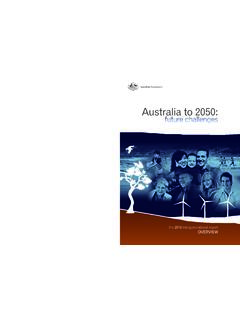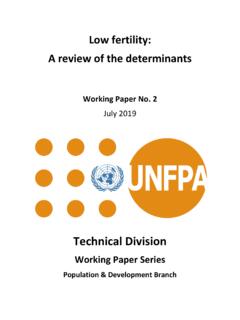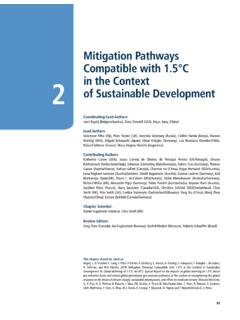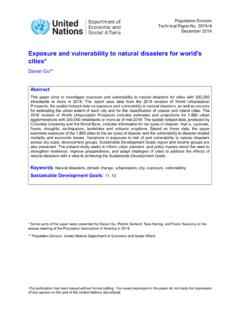Transcription of Obesity Update 2017 - OECD
1 Obesity Update 2017. Policy insights Did you know? More than one in two adults and nearly one in six children are overweight or obese in OECD countries. Adult Obesity rates are highest in the United States, Mexico, New Zealand and Hungary, while they are lowest in Japan and Korea. Obesity rates are projected to increase further by 2030, and Korea and Switzerland are the countries where Obesity rates are projected to increase at a faster pace. Social inequalities in overweight and Obesity are strong, especially among women. In about half of the eight countries for which data are available, less- educated women are two to three times more likely to be overweight than those with a higher level of education.
2 In the last few years, some OECD countries have relied on fiscal policies to increase the price of potentially unhealthy products to encourage a healthier diet such as in Belgium, Chile, Finland, France, Hungary and Mexico. This Obesity Update focusses on communication policies designed to empower people to make healthier choices, which are increasingly used in OECD. countries. New developments in communication policies include new easy-to- understand schemes of food labelling, mass media campaigns to increase public awareness, the use of social networks and new technologies for health promotion campaigns, and reinforced regulation of marketing of potentially unhealthy products, especially when directed to children.
3 Comprehensive policy packages, including not only communication but also school-based interventions, interventions in primary care settings, and broader regulatory and fiscal policies, provide an affordable and cost-effective solution to tackle Obesity . OECD 2017. Obesity Update - OECD 2017. Obesity Update 2017: introduction Today, more than one in two adults and nearly one in six children are overweight or obese in the OECD. area. The Obesity epidemic has spread further in the past five years, although at a slower pace than before. Despite this, new projections show a continuing increase of Obesity in all studied countries.
4 Social disparities in Obesity persist and have increased in some countries. A nearly tenfold variation in Obesity and overweight rates can be seen across OECD countries. In the last few years, new policy strategies devised to fight Obesity have emerged. This Obesity Update focusses on a selection of those, specifically at communication policies aimed to tackle Obesity , in particular by improving nutrient information displayed on food labels, using social and new media to sensitise the population , or by regulating the marketing of food products. Better communication helps empower people to make healthier choices.
5 However, comprehensive policy packages, including not only communication but also broader regulatory and fiscal policies, are needed to tackle Obesity effectively. 1. Obesity Update - OECD 2017. One in five adults is obese in OECD countries In 2015, across the OECD, of the adult population was obese (Figure 1). This rate ranges from less than 6% in Korea and Japan to more than 30% in Hungary, New Zealand, Mexico and the United States. More than one in four adults is obese in Australia, Canada, Chile, South Africa and the United Kingdom. Overweight and Obesity rates have grown rapidly in England, Mexico and the United States since the 1990s, while the increase has been slower in the other seven OECD countries for which trend data are available (Figure 2).
6 Over the past decade, the prevalence rate of overweight and Obesity has increased in Canada, France, Mexico, Switzerland and the United States, while it has stabilised in England, Italy, Korea and Spain. There is, however, no clear sign of retrenchment of the epidemic, in any country. Nearly one in six children is overweight or obese The share of children who are overweight or obese at age 15 ranges from 10% in Denmark to 31% in the United States (Figure 3). Despite policies put in place in OECD countries for a number of years, the number of 15-year-olds who report to be overweight or obese has steadily increased since 2000 in the majority of countries, according to the Health Behaviour in School-aged Children survey (Inchley et al.)
7 , 2016). A more detailed analysis covering children aged 3 to 17 at several points in time shows relatively stable rates in France up to 2012, while trends have been somewhat upward again for both boys and girls in England since 2012, and since 2011. for boys in the United States (Figure 4). 2. Obesity Update - OECD 2017. Figure 1: Obesity among adults, 2015 or nearest year Japan Self-reported data Women Korea Measured data Italy Men Switzerland Norway Sweden Netherlands Austria Denmark France Slovak Rep. Portugal Poland Spain 17 Greece Israel 18 Estonia Belgium 19 Iceland Slovenia OECD.
8 21 Czech Rep. Latvia Turkey Luxembourg 23 Ireland Germany Finland Chile Canada United Kingdom Australia 30 Hungary New Zealand Mexico United States India Indonesia China Lithuania Russian Fed. Brazil Colombia Costa Rica South Africa 40 30 20 10 0 0 10 20 30 40. % of population aged 15 years and over % of population aged 15 years and over Source: OECD (2017), OECD Health Statistics 2017 (Forthcoming in June 2017). Note: The statistical data for Israel are supplied by and under the responsibility of the relevant Israeli authorities. The use of such data by the OECD is without prejudice to the status of the Golan Heights, East Jerusalem and Israeli settlements in the West Bank under the terms of international law.
9 3. Obesity Update - OECD 2017. Figure 2: Rising overweight (including Obesity ) rates in adults aged 15-74 years 80%. Rates of overweight (including Obesity ). Mexico 70% United States 60% Hungary England Canada 50%. Spain France 40% Italy Switzerland 30% Korea 20%. 1972 1976 1980 1984 1988 1992 1996 2000 2004 2008 2012 2016. Year Note: Overweight and Obesity rates designate overweight and Obesity prevalence rates. Age- and gender-adjusted rates of overweight (including Obesity ), using the 2005 OECD standard population . Measured height and weight in England, Hungary, Korea, Mexico and the United States; self-reported in other countries.
10 Source: OECD analysis of health survey data. Figure 3: Self-reported overweight (including Obesity ) in children aged 15 years 2001-02 2013-14. 35. 30. 31. 25. 20. %. 18. 17. 17. 17. 15. 16. 16. 16. 15. 15. 14. 14. 14. 13. 12. 12. 10. 12. 5. 0. *. *. Note: * Data for 2009-10. Child overweight is defined with IOTF age- and gender- specific BMI cut-offs. Source: Currie, C. et al. (2004); Inchley et al. (2016). 4. Obesity Update - OECD 2017. Figure 4: Obesity in children aged 3-17 years 25%. 20%. 15%. Rates of child Obesity 10%. 5%. 0%. 1990 1995 2000 2005 2010 2015.
















